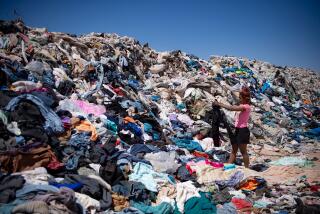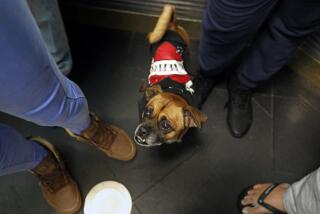Goodwill Ambassador : To Leonel Barragan, Who Manages the Charityâs Sales in Orange County, Those Castoffs Arenât Junk, but Things People in Poor Countries Can Use
SANTA ANA â Under this vast sheet-metal roof sails a convoy of worn sofas with an escort of scuffed easy chairs; over there a graveyard of electrical appliances featuring an antique VCR the size of a small suitcase; kitchen chairs in rows, no one matching another; dozens of ties fluttering in the warm breeze; hundreds of records, not all of them with jackets; dozens of crutches stacked in a corner as if some faith healer had just come through and conducted a very successful revival; a platoon of commodes and sinks in various shades of listless pastels; sheaves of skis; and bin after bin of mostly cheap clothes in mostly garish colors.
This is the last stop before the scrap heap or the landfill. This is junk, big-time. This is Goodwill Industriesâ As Is shop.
Leonel Barragan reigns over this kingdom of hand-me-downs. (As a matter of fact, he bought the tie heâs wearing from that rack right over there.) His title is sales manager. Barragan is in charge of moving tons of this stuff every week from Goodwillâs 10 retail stores to the end of the line--this store half the size of a football field and covered only by the tin roof.
People come from as far away as Ensenada. By the pound, goods cost only $1.60, and if you buy by the cartload--as many do--it costs only 25 cents a pound. Theyâll haul the stuff back across the border and sell it at flea markets in Tijuana and Ensenada and Calexico.
âIâve seen people in Calexico selling seven pieces of clothing for a buck,â Barragan says. âTheyâre making a profit, but itâs nowhere near 100%.â
A half-dozen pickup trucks and vans, most sporting powder-blue Mexican license plates, are parked just outside the store. The drivers are sorting through carts as tall as a man; what little they leave will go for salvage. You can see a small plastic hobby horse, a jumble of clothing and a tennis racquet through the metal bars of a cart. One pickup is stacked high with mattresses; on top of those is a box of oil paintings in heavy painted frames teetering four feet over the truckâs cab.
One manâs junk is another manâs treasure, especially in the Third World, where it seems hardly anything gets thrown away; where old tires get made into sandals and packing crates into homes.
âA garment may be out of style,â says George W. Kessinger, president of the local Goodwill and Barraganâs boss, âbut itâll still keep you warm.
âSo you have a couple of alternatives with that garment: You can put it in a landfill and screw up the environment, or you can turn it into an expensive washrag. Or you can make it so that somebody gets some use from it.â
Because of the big demand from buyers, most of whom are Mexican, Barragan is making plans to purchase truckloads of stuff that Goodwill stores in the Midwest donât want.
And Goodwill has even found a market for the broken wheelchairs, dented typewriters and unfashionable clothing that Mexican traders reject. Eighteen months ago, Kessinger sent 500 pounds of stuff to the Goodwill store in Montevideo, Uruguay, to see what would happen.
Every bit of it got used.
Take, for instance, the wheelchair that got fixed up and sold to a 14-year-old girl with cerebral palsy who had never had a silla de ruedas before. In the United States, the wheelchair would have been sold for scrap for about 3 cents a pound, or put into a landfill.
Barragan has seen poverty at close range: He spent his first 18 years in Mexico. When he came to this country with the rest of his family to join his father, he didnât speak English.
And that wasnât his only obstacle: Childhood polio left him with a brace on his left foot and a rolling walk that persists to this day, even as Barragan turns the corner into his 40s. His first job in the United States, he says, was at Goodwill, sorting the stuff that came in to the As Is shop. Heâs been here ever since.
Last year, encouraged by the success of the first shipment to Uruguay, Barragan and Kessinger sent an even larger load there--a 30,000-pound truckload.
It cost $6,000 to send by ship, and the Uruguay Goodwill is halfway through paying off the shipping charges. The shipment itself was free, but Kessinger, although he works for a nonprofit organization, takes a businesslike approach to managing Goodwill. He hopes to put the next shipment on a paying basis with Montevideo.
âWhen we first started talking to them, they thought we were proposing a typical charitable contribution, not a business deal,â Kessinger says. âThey kept asking âWhereâs the check? Whereâs the check?â It took us a while to convince them there wasnât going to be a check, just a chance to start a new business.â
At first, Kessinger and Barragan thought they might be able to send as many as four big shipments a year to Uruguay. In fact, though, Montevideoâs $12,000-a-year operation is still working on selling off the last shipment.
There were other problems, too: The clothes in the big cargo container that carried the last shipment came in 800-pound bales 3 feet wide by 4 feet tall that were a little hard to heft without a forklift. The Montevideo Goodwill has no forklift.
âTheyâd probably never seen so much merchandise at one time,â Barragan says.
Kessinger and Barragan are trying to persuade the Delaware Goodwill to start shipping to Montevideo, since each city is on the east coast of its continent, thus making shipping cheaper. The Santa Ana Goodwill would then look for a country on the west coast of South America to do business with, possibly Peru.
Meanwhile, this idea of selling stuff abroad that Americans neither need nor want seems to be catching on: the Goodwill in Fort Myers, Fla., says Kessinger is trying to open a store in Moscow.
Which goes to show you that the Goodwill philosophy translates into more languages than English. Itâs summed up by Kessinger: âWhen the customer says itâs not valuable, then itâs a rag.â


